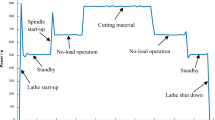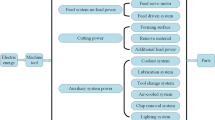Abstract
Stainless steel is a kind of difficult-to-machine material, and the work hardening in milling easily leads to high energy consumption and poor surface quality. Thus, the influence of machined surface hardness on energy consumption and surface quality cannot be ignored. To solve this problem, the prediction models for machine tool specific energy consumption and surface roughness are developed with tool wear and machined surface hardness considered firstly. Then, the validity of the models is verified through AISI 304 stainless steel milling experiments. The results show that the prediction accuracy of the machine tool specific energy consumption model can reach 98.7%, and the roughness model can reach 96.8%. Later, according to the developed prediction models, the influence of milling parameters, surface hardness, and tool wear on the machine specific energy consumption and surface roughness is studied. Results show that in stainless steel milling, the most significant parameter for surface roughness is the machined surface hardness, while that for energy consumption is the feed per tooth. The machine specific energy consumption increases linearly with the increase of the tool wear and the machined surface hardness gradually. The proposed models are helpful to optimize the process parameters for energy-saving and high-quality machining of stainless steel.













Similar content being viewed by others
Data availability
All the data have been presented in the manuscript.
Code availability
Not applicable
References
Trappey AJC, Trappey CV, Hsiao CT, Ou JJR, Chang CT (2012) System dynamics modelling of product carbon footprint life cycles for collaborative green supply chains. Int J Comput Integr Manuf 25(10):934–945. https://doi.org/10.1080/0951192X.2011.593304
Zhao GY, Liu ZY, He Y, Cao HJ, Guo YB (2017) Energy consumption in machining: classification prediction, and reduction strategy. Energy 133:142–157. https://doi.org/10.1016/j.energy.2017.05.110
Kara S, Li W (2011) Unit process energy consumption models for material removal processes. CIRP Annals 60(1):37–40. https://doi.org/10.1016/j.cirp.2011.03.018
Li L, Yan JH, Xing ZW (2013) Energy requirements evaluation of milling machines based on thermal equilibrium and empirical modeling. J Clean Prod 52:113–121. https://doi.org/10.1016/j.jclepro.2013.02.039
Zhang HC, Kong LL, Li T, Chen JC (2015) SCE modeling and influencing trend analysis of cutting parameters. China Mech Eng 26(08):1098–1104. https://doi.org/10.3969/j.issn.1004-132X.2015.08.019
Li CB, Xiao QE, Li L, Zhang XF (2015) Optimization method of NC milling parameters for energy efficiency based on Taguchi and RSM. Comput Integr Manuf Syst 21(12):3182–3191. https://doi.org/10.13196/j.cims.2015.12.010
Liu N, Wang SB, Zhang YF, Lu WF (2016) A novel approach to predicting surface roughness based on specific cutting energy consumption when slot milling Al-7075. Int J Mech Sci 118:13–20. https://doi.org/10.1016/j.ijmecsci.2016.09.002
Zhao GY, Su Y, Zheng GM, Zhao YG, Li CX (2020) Tool tip cutting specific energy prediction model and the influence of machining parameters and tool wear in milling. Proc Inst Mech Eng B J Eng Manuf 234(10):1346–1354. https://doi.org/10.1177/0954405420911298
Debnath S, Reddy MM, Yi QS (2016) Influence of cutting fluid conditions and cutting parameters on surface roughness and tool wear in turning process using Taguchi method. Measurement 78:111–119. https://doi.org/10.1016/j.measurement.2015.09.011
Mativenga PT, Rajemi MF (2011) Calculation of optimum cutting parameters based on minimum energy footprint. CIRP Annals 60(1):149–152. https://doi.org/10.1016/j.cirp.2011.03.088
Al-Hazza MHF, Adesta EYT, Ali AM, Agusman D, Suprianto MY (2011) Energy cost modeling for high speed hard turning. J Appl Sci 11:2578–2584. https://doi.org/10.3923/jas.2011.2578.2584
Quintana G, Ciurana J, Ribatallada J (2011) Modelling power consumption in ball-end milling operations. Mater Manuf Process 26(5):746–756. https://doi.org/10.1080/10426910903536824
Carmita CN (2015) Optimization of cutting parameters using response surface method for minimizing energy consumption and maximizing cutting quality in turning of AISI 6061 T6 aluminum. J Clean Prod 91:109–117. https://doi.org/10.1016/j.jclepro.12.017
Hanafi I, Khamlichi A, Cabrera FM, Almansa E, Jabbouri A (2012) Optimization of cutting conditions for sustainable machining of PEEK-CF30 using TIN tools. J Clean Prod 33(8):1–9. https://doi.org/10.1016/j.jclepro.2012.05.005
Peng T, Xu X (2014) Energy-efficient machining systems: a critical review. Int J Adv Manuf Technol 72(9-12):1389–1406. https://doi.org/10.1007/s00170-014-5756-0
Parida AK, Maity K (2019) Modeling of machining parameters affecting flank wear and surface roughness in hot turning of Monel-400 using response surface methodology (RSM). Measurement 137:375–381. https://doi.org/10.1016/j.measurement.2019.01.070
Liu ZY, Guo YB, Sealy MP, Liu ZQ (2015) Energy consumption and process sustainability of hard milling with tool wear progression. J Mater Process Technol 229:305–312. https://doi.org/10.1016/j.jmatprotec.2015.09.032
Wang B, Zhang Q, Wang MH, Zheng YH, Kong XJ (2020) A predictive model of milling surface roughness. Int J Adv Manuf Technol 108(3):2755–2762. https://doi.org/10.1007/s00170-020-05599-x
Kumar SPL (2019) Measurement and uncertainty analysis of surface roughness and material re-moval rate in micro turning operation and process parameters optimization. Measurement 140:538–547. https://doi.org/10.1016/j.measurement.2019.04.029
Kant G, Sangwan KS (2014) Prediction and optimization of machining parameters for minimizing power consumption and surface roughness in machining. J Clean Prod 83:151–164. https://doi.org/10.1016/j.jclepro.2014.07.073
Li B, Tian XT, Zhang M (2020) Modeling and multi-objective optimization of cutting parameters in the high-speed milling using RSM and improved TLBO algorithm. Int J Adv Manuf Technol 111:7–8. https://doi.org/10.1007/s00170-020-06284-9
Zhou LR, Li FY, Li JF, Cheng CL, Kong L (2018) Milling machine power model considering workpiece material hardness. Comput Integr Manuf 24(04):905–916. https://doi.org/10.13196/j.cims.2018.04.010
Zhao GY, Li CX, Lv Z, Cheng X, Zheng GM (2020) Specific energy consumption prediction model of CNC machine tools based on tool wear. Int J Comput Integr Manuf 33(2):159–168. https://doi.org/10.13196/j.cims.2018.04.010
Funding
This work was supported by the key projects of Shandong Province Natural Science Foundation of China [ZR2020KE060].
Author information
Authors and Affiliations
Corresponding author
Ethics declarations
Conflict of interest
The authors declare no competing interests.
Additional information
Publisher’s note
Springer Nature remains neutral with regard to jurisdictional claims in published maps and institutional affiliations.
Rights and permissions
About this article
Cite this article
Yu, S., Zhao, G., Li, C. et al. Prediction models for energy consumption and surface quality in stainless steel milling. Int J Adv Manuf Technol 117, 3777–3792 (2021). https://doi.org/10.1007/s00170-021-07971-x
Received:
Accepted:
Published:
Issue Date:
DOI: https://doi.org/10.1007/s00170-021-07971-x




